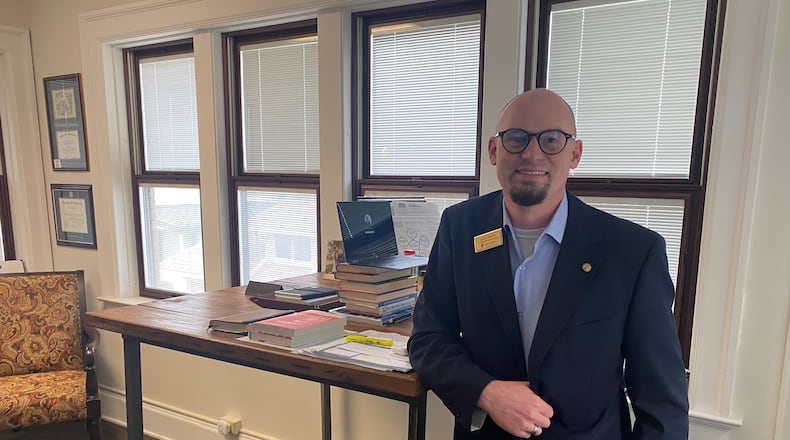The findings have been found in the local workforce, particularly in fields like health care and others that are trying to maintain the same level of services with fewer employees.
“They’re more stressed than they were before,” Dr. Christina Waite, medical director for psychiatry at Miami Valley Hospital, said about workers now compared to before the pandemic. “Especially in health care. Their work load has increased tremendously because we have fewer workers doing the same amount of work.”
What is a toxic workplace?
Google searches on the signs of a toxic work environment have gone up in the past 90 days, according to Google trends, but the topic has seen growing interest throughout the pandemic, with related queries going up 100% to 120% over the past 12 months.
When employees feel stonewalled versus heard, pushed around or minimized, it can lead to a difficult or even toxic work environment.
“The definition is really that it’s a negative situation or negative behaviors that are accruing in a work environment that creates a lack of trust and high stress levels,” Waite said. “And this becomes the norm … It’s the culture of the workplace.”
When employees don’t know when to turn off working for the day can also lead to a toxic work environment.
John Davis, associate vice president for Human Resources at Cedarville University, said the COVID-19 pandemic showed that employees could work apart, but working from home led to a disruption in a work-life balance. Feeling a pressure to keep working outside of regular work hours is where a job could become toxic, he said.
What are the affects of a toxic workplace?
The outcome of a toxic work environment is employees feel psychologically unsafe, Waite said. A toxic work environment can also breed conflict between coworkers, causing some employees to feel contempt for each other.
Employee burnout, resignations, high employee turnover rates, and a disengaged workforce can result from a toxic work environment being left unaddressed and unresolved.
“It is detrimental, not only to the individual, but to the team,” Waite said. “You get a huge turnover. Staff won’t stay.” Waite said generation Z workers seem more inclined to seek other employment if they’re unhappy.
Christopher Walton, Montgomery County workforce specialist with the Montgomery County Job Center, said the trends he is seeing with the individuals he has worked with are individuals branching out to start new businesses or taking the time to find the right career for them that fits their lifestyles.
“Job seekers have options and are actively seeking companies and positions that align with their needs in terms of pay, benefits and work-life balance,” Walton said. “In order to attract candidates, employers are having to take a really close look at their current offerings and considering what else they can provide to stay competitive with other companies.”
Those who are left at a toxic workplace also continue to experience the impact of the toxic work environment as they feel exhausted from the work load and become disengaged from the work itself, potentially impacting productivity and quality standards.
“It’s hard to turn it around because the people left are exhausted,” Waite said.
How can individuals and employers address these situations?
As part of his responsibilities at Cedarville University, Davis also teaches human resources management to university students, including how managers and employers can care for their employees.
Davis teaches his students with the acronym “CARE,” meaning that employers should communicate as a leader and with an open mindset within the organization, ask employees for input, recognize there is a work life balance and it matters, and also example unity. Communication helps employees understand decision points, as well as make their voices feel heard when their employers ask for their opinions.
It’s also okay not to work 24/7.
“You need to take time to not work apart from these expected hours of work,” Davis said. In a practical example of how businesses can operate efficiently while still giving employees time off is the “80-20 rule,” meaning employers can cross train their employees on their coworkers’ jobs, giving them a 20% understanding of their coworkers’ jobs to cover what is in needed in their absence.
“I can step in, and I can bring relief,” Davis said. Additionally, employers example unity by giving employees the full picture, such as, “this is where we’re going, these are the things that are important, these are the things that are not,” Davis said.
The U.S. Surgeon General also suggests five essentials for workplace mental health and well-being. Those components include the following, according to the Office of the U.S. Surgeon General:
- Protection from harm: prioritize workplace physical and psychological safety, enable adequate rest, normalize and support mental health, and operationalize diversity, equity, inclusion, and accessibility norms, policies, and programs
- Work-life harmony: provide more autonomy over how work is done, make schedules as flexible and predictable as possible, increase access to paid leave, and respect boundaries between work and non-work time
- Mattering at work: provide a living wage, engage workers in workplace decisions, build a culture of gratitude and recognition, and connect individual work with organizational mission
- Connection and community: create cultures of inclusion and belonging, cultivate trusted relationships, and foster collaboration and teamwork
- Opportunity for growth: offer quality training, education, and mentoring; foster clear, equitable pathways for career advancement; and ensure relevant, reciprocal feedback
The Montgomery County Job Center also offers employee assistance, such as job training grants and one-on-one career help, as well as help with recruiting for employers. If you’re a job seeker looking for work or an employer looking for qualified candidates, call 937-225-JOBS (5627) or TheJobCenter.org.
About the Author



